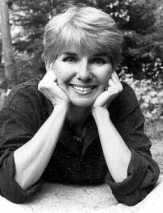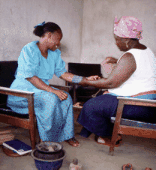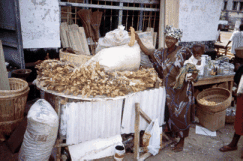

|
Exploring indigenous healing knowledge from Africa to Alberta |

Nancy Gibson: Assistant Professor, Department of Public Health Sciences |
One day in 1994, Nancy Gibson was making the rounds with a local doctor, Sama Banya, in a Sierra Leonean hospital. They examined an old woman with gonorrhea. Gibson's nursing training kicked in. "I said we have to find her husband. We'll have to check him, treat them both and everything will be fine." The Sierra Leonean nurses' eyes glazed over.
Banya took Gibson out into the hall. "Nancy, she's one of four wives," he explained. "Her husband has other mistresses and lovers. Each of the wives have lovers." The local doctor explained that it simply wasn't possible to employ the western model in this particular situation. At that moment Gibson remembered a phrases associated with one of Emily Carr's books: "fresh seeing."
The situation indeed called for "fresh seeing."

Traditional healers in Sierra Leone are integral players in the health care system. |
While conducting research for her PhD in medical antrhopology, Gibson learned about the central role traditional healers play in the war-wracked West African country, about the healers' incredible knowledge of curative herbs. She also saw how the western medical model was being used in collaboration with, and along side of, the traditional healers' methods. She discovered a country where a traditional healers association exists -- but returned to one in which aboriginal healers are marginalized and discounted by the dominant medical practitioners.
Fortunately, when she returned to Canada she landed a job in a department where people are encouraged to see public health issues from fresh perspectives. The assistant professor of Public Health Sciences is now applying what she learned in Sierra Leone to the Canadian scene. "Sierra Leone taught me that indigenous knowledge is a resource ... and there are parallels across Canada in aboriginal communities." But that knowledge has been discounted. "The central culture has said 'Oh, that's just traditional healing. You really need to see a doctor.'"

Curative herbs are sold by healers in Sierra Leone markets. |
However, there is a growing recognition in this country that aboriginal healers will have a bigger role to play in public health issues -- particularly if we are to overcome the enormous health problems in aboriginal communities -- and that the dichotomy between the two medical models is crumbling. Gibson is helping to acceslerate that process. A medical continuum is taking form. She, and many of her colleagues in the department and those associated with the Canadian Circumpolar Institute, are engaged in "softening the edges" of the scientific model, serving as "cultural brokers" between the two bodies of knowledge. A lot of that collaborative, community-based work is being conducted with the Whitefish Lake First Nation in northern Alberta.
In Africa, some healers know remedies for one disease. Others work with specific herbs and nothing else. Some deal primarily with the religious component. In Canada, again there are parallels. "Interest is growing. More and more people are speaking about traditional healing. There are more healing lodges. There's a growing reverence for that knowledge. And there's a more open sharing of that knowledge -- even among non-native people."
All this is happening at a time when aboriginal people are enrolling in greater numbers in the health sciences at the University of Alberta. "Many come with knowledge of traditional healing and want to learn the other model; many want to work both sides of the fence," she explains.
"Our knowledge isn't any more valuable than theirs. Without the two, we can't achieve any sustainable improvements."
![[Folio]](http://www.ualberta.ca/~publicas/folio/gif/small/folio.gif)
Folio front page |
![[Office of Public Affairs]](http://www.ualberta.ca/~publicas/gif/small/opahome.gif)
Office of Public Affairs |
![[University of Alberta]](http://www.ualberta.ca/~publicas/gif/small/uahome.gif)
University of Alberta |